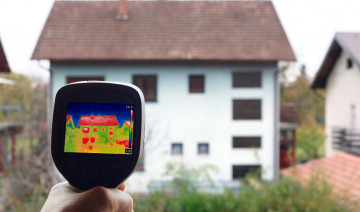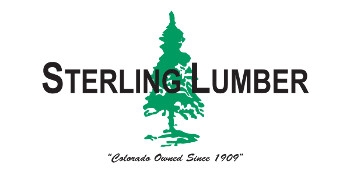
Holes in the Wall: Understanding Total R-Value
If you look at a building's thermal envelope as a six-sided cube, the walls represent the largest surface area and have the weakest R-value.
When the goal is to improve the thermal efficiency of that envelope, the walls have the most room for improvement. We can increase their R-value by making them thicker or by using insulation with a higher R-value per inch, but unfortunately, framing a thicker, better-insulated wall is only one piece of the puzzle. We also have to deal with the thermal bridging associated with traditional framing methods and we have to improve the windows. In fact, it's the windows that have become the weakest link in a high-performance wall.

When it comes to improving the energy efficiency of a building, lots of attention is paid to insulation R-values, thermal bridges, and air sealing. But don’t forget the windows, which account for the biggest energy loss in a high-R wall.
Builders have learned, for the most part, to mitigate thermal bridging by using alternative framing techniques, continuous exterior rigid foam products, or both. Wood framing materials have a resistance to heat flow (R-value) that is roughly one third that of common insulation products such as fiberglass and cellulose. Because heat energy will choose the path of least resistance, the framing members become the heat energy's "bridge" to the outdoors. Without addressing these thermal bridges, the overall R-value of any wall system is weakened immensely, regardless of the insulation type installed in the cavities between framing members.
Advanced framing (24-inch on-center studs with single top plates) by itself can increase overall wall R-value by only 4% to 6%. To really address thermal bridging, many builders are also incorporating continuous exterior rigid insulation or using alternative construction methods, such as staggered stud walls, double walls, or I-joist walls to tackle the thermal bridging problem (see "Building Above-Code Walls," JLC Dec/13).

Uo of Standard 2x6 Wall Assembly: R-23 in cavities (framing = 23% of wall area). Without windows: R-18 Overall. With windows at 15% of wall area: Window U = 0.30, R = 11 Overall.
Thermal bridging is the low-hanging fruit. Pick off the energy losses due to thermal bridges, and the next weakest link in any wall assembly is the window.
So here's the question: Does it make more sense to frame an 18-inch-thick wall with double-pane windows; a 12-inch-thick wall with triple-pane U.S.-made windows; or a 6-inch-thick wall with triple-pane European windows? For most projects with a substantial heating or cooling load, the answer may not be any of these. It probably lies somewhere in the middle, and to find it, you'll need to evaluate a wall's total R-value, not just insulation R-value.
The illustration above shows the effect of a typical U-0.3 window on the R-value of a typical 2x6 framed wall. Through a simple Uo (area-weighted U-value) calculation, we see the impact of thermal bridging and heat flow through the window: R-11, which is not a great R-value in any climate.
Now look at the illustration below to see what happens when you put a lot of effort into framing a super-insulated wall. If you focus all the attention on wall insulation and framing but do nothing to improve window performance, you're not doing as much as you might think to improve the energy performance of the building. We must ask ourselves, how good is good enough? At what point does it make more sense to purchase better windows than to increase the overall R-value in the wall?

Uo of 18-Inch Wall Assembly: R-61 in cavities (framing = 18% of wall area). Without windows: R-60 Overall.With windows at 15% of wall area: Window U = 0.30, R-17 Overall.
It may be that the best option is a balance of insulation and window performance. Address the thermal bridging and improve the cavity insulation with, say, a 12-inch double wall, as shown below, but improve the window U-value, too. It quickly becomes apparent that improving window performance is a more effective path for improving wall performance than simply adding more insulation.
A Uo calculation can help convey some effects of design choices, but a comprehensive energy modeling tool can help a project team extract other useful information, such as the effects on overall energy loads, energy losses through various building components, and mechanical-system sizing. Using local utility cost data, energy modeling software can help project teams understand payback periods and plug numbers into a cost-benefit analysis for their clients. Of course, the availability of materials and skilled labor can be significant factors as well.
When contractors are attempting to reach a performance goal such as Passive House or Net Zero Energy, the thermal performance of the windows cannot be overlooked. If the cost of the windows is an obstacle, has the project team considered using fewer windows? Or moving windows to a more favorable position with respect to the sun? Has the project team considered re-orienting the room layout to work better with a re-orientation of the windows?

Uo of 12-Inch Wall Assembly: R-41 in cavities (framing = 18% of wall area).Without windows: R-39 Overall.With windows at 15% of wall area: U = 0.30, R-15 Overall. With improved windows at 15% of wall area: U = 0.15, R-22 Overall. With even better windows at 15% of wall area: U = 0.10, R-27 Overall.
When considering window orientation, keep in mind that it's possible to have windows that are sometimes referred to within the Passive House community as "net gainers." With the right climate, envelope, orientation, and design, the right windows can actually gain more solar heat energy in the daytime than they lose overnight. Without a good energy modeling tool to confirm this assumption, however, it's a safer bet to assume the opposite.
Passive solar homes of the 1970s used this same technique but incorporated large quantities of thermal mass to absorb the heat energy coming in through windows. Most high-performance building envelopes today can accomplish a similar goal without a large thermal mass and are less prone to overheating, as long as a good shading strategy is incorporated into the design.
